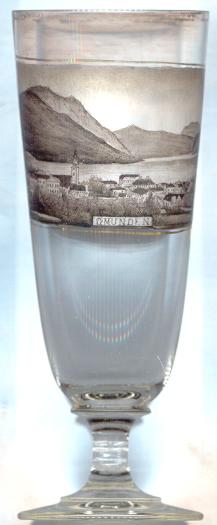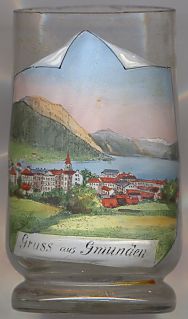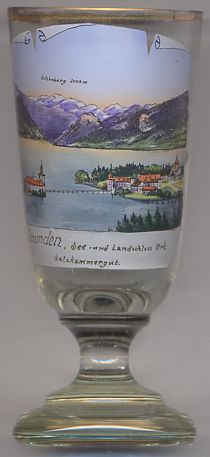

|
| ÖSTERREICH | AUSTRIA |
| Bundesland: Oberösterreich | Upper Austria |
| Bezirk: Gmunden |

 The district town Gmunden is situated at an elevation of 440 m on the northern end of Lake Traunsee at the effluence of the river Traun.
The first mentioning in a document dates back to around AD 909.
Until the 19th century, Gmunden was the most flourishing trading town (especially in salt) in the Salzkammergut region of Upper Austria.
The horse carriage railway from Linz to Gmunden was completed in 1842.
The district town Gmunden is situated at an elevation of 440 m on the northern end of Lake Traunsee at the effluence of the river Traun.
The first mentioning in a document dates back to around AD 909.
Until the 19th century, Gmunden was the most flourishing trading town (especially in salt) in the Salzkammergut region of Upper Austria.
The horse carriage railway from Linz to Gmunden was completed in 1842.
The  parish church Jungfrau Maria und Heilige Drei Könige (Virgin Mary and Three Magi) [centre left]
goes back to the first half of the 14th century, the time of the foundation of the parish of Gmunden. The Gothic basilica was remodelled in Baroque style in 1713–1718 by Johann Michael Prunner who also added the west tower.
The most important treasure of the church is the high altar ('Dreikönigsaltar') with a group of wooden sculptures depicting the Three Magi, carved by
the famous Thomas Schwanthaler in 1678.
parish church Jungfrau Maria und Heilige Drei Könige (Virgin Mary and Three Magi) [centre left]
goes back to the first half of the 14th century, the time of the foundation of the parish of Gmunden. The Gothic basilica was remodelled in Baroque style in 1713–1718 by Johann Michael Prunner who also added the west tower.
The most important treasure of the church is the high altar ('Dreikönigsaltar') with a group of wooden sculptures depicting the Three Magi, carved by
the famous Thomas Schwanthaler in 1678.

 Castle Ort [near left, no. 2239]
is the landmark of Gmunden. The older part of the castle (Seeschloss) is located on a small island in the lake which is connected
to the shore by a long wooden bridge. The castle is one of the oldest preserved structures of the Salzkammergut region.
The earliest mentions of it are found in documents of AD 909 and 1053.
The first owners of the castle were the counts of Hartscheid. After 1244 its owners changed several times. In 1483 it came in
possession of Emperor Friedrich III. At the end of the 16th century, the castle was purchased by the city of Gmunden
which had become wealthy by salt trading. However, Gmunden returned the castle to Emperor Rudolf II because
the costs of uptaining the structure had become to expensive. In 1620, Adam Count Herberstorff, Bavarian governor of
Upper Austria, purchased the castle. During the Peasants' Wars, the castle was looted and burnt to the ground in 1626.
In 1634 the castle was rebuilt and the castle on the shore (Landschloss) was added. Both castles remained in possession of the
Herberstorff family until 1630 when they were returned to the Habsburg emperors. In 1867 the Habsburg Archduke Leopold II of
Tuscany purchased the castle and gave it to his son, Archduke Johann Salvator of Austria-Tuscany. In the following thirty years the
archukes of Tuscany purchased large parts of the area and made it their seat when they were exiled from their former country.
In 1889 he voluntarily renunced his titles and assumed the name Johannes Orth (after his castles at Gmunden). In the same year
Johann Salvator married Milli Strubel, ballet dancer at the Vienna Court Opera. In 1890 he went on a world tour with a sailing ship
but went missing and probably was killed in the South Atlantic; he was declared dead in 1911. After that, the two castles
fell back to the Austrian Emperor Franz Joseph I. Between 1996 and 2004 the lake castle was used as stage for the TV
series "Schlosshotel Orth".
Castle Ort [near left, no. 2239]
is the landmark of Gmunden. The older part of the castle (Seeschloss) is located on a small island in the lake which is connected
to the shore by a long wooden bridge. The castle is one of the oldest preserved structures of the Salzkammergut region.
The earliest mentions of it are found in documents of AD 909 and 1053.
The first owners of the castle were the counts of Hartscheid. After 1244 its owners changed several times. In 1483 it came in
possession of Emperor Friedrich III. At the end of the 16th century, the castle was purchased by the city of Gmunden
which had become wealthy by salt trading. However, Gmunden returned the castle to Emperor Rudolf II because
the costs of uptaining the structure had become to expensive. In 1620, Adam Count Herberstorff, Bavarian governor of
Upper Austria, purchased the castle. During the Peasants' Wars, the castle was looted and burnt to the ground in 1626.
In 1634 the castle was rebuilt and the castle on the shore (Landschloss) was added. Both castles remained in possession of the
Herberstorff family until 1630 when they were returned to the Habsburg emperors. In 1867 the Habsburg Archduke Leopold II of
Tuscany purchased the castle and gave it to his son, Archduke Johann Salvator of Austria-Tuscany. In the following thirty years the
archukes of Tuscany purchased large parts of the area and made it their seat when they were exiled from their former country.
In 1889 he voluntarily renunced his titles and assumed the name Johannes Orth (after his castles at Gmunden). In the same year
Johann Salvator married Milli Strubel, ballet dancer at the Vienna Court Opera. In 1890 he went on a world tour with a sailing ship
but went missing and probably was killed in the South Atlantic; he was declared dead in 1911. After that, the two castles
fell back to the Austrian Emperor Franz Joseph I. Between 1996 and 2004 the lake castle was used as stage for the TV
series "Schlosshotel Orth".
The mountain in the background of the pictuer on glass no. 2241 is the
 Schönberg
Schönberg
The  Traunsee
Traunsee
The humanist Johannes von Gmunden (1380/84–1442) was born in Gmunden. He was a mathematician and astronomer at the University of Vienna
and brought the mathematical and astronomical knowledge of Antiquity and of Arabian scholars to Central Europe. He published the first printed calendar in
the German language and is credited with the first map ('Albertinischer Plan') of Vienna. Before his death in Vienna,
he was priest in Laa an der Thaya.
![[scale]](lineal.jpg)